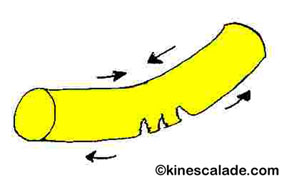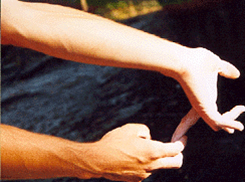|
Finger flexor tendinitis
Definition
The word tendinitis refers to inflammatory damage of the tendinous structure. Nowadays, it is recognized that most of the time this term is wrongly used to describe a tendinosis, that is a degenerative condition with micro-rupture of the tendon. In that case, the inflammatory condition is just one of the consequences.
In the case of fingers, the flexors of the tendons have to support huge pressure which could cause micro-ruptures.
Usually, a distinction is made between several stadiums in tendon conditions. These are:
1) pain during the warm-up which disappears once warm.
2) the pain persists after the warm-up and then also at rest.
The « tendinitis » is evident when pain is felt during palpation, contraction and stretching.
Mechanism of the lesion
The tendon wears out like a rope exposed to tension and high friction.
The higher tension and friction the more it wears out.
Crimp holds (fig 1) favour friction on the pulleys and exert tension on the parts situated in the convexity of the curve of the tendon (fig 2).
The impact on the tendons caused by the reception of a dyno (dynamic movement) are most probably the principal cause of this condition. The phenomenon is increased when crimping the reception hold.
Ones again, it is important to take into account that the repetition of the movement is really harmful for the structures.
 |
Fig 1: Schematic strain of the tendon in a crimp |
 |
Fig 2: Strain on the convexity of the tendon |
Prevention
Technique correction:
Use open hand grips as often as you can. Place your feet properly so as to relieve the tension in the tendons.
Correction of the exercise schedule:
Take a rest of 1 day between each maximum strength session for the fingers. The strength cycle should not exceed 3 weeks.
Do not exceed 3 strength sessions per week. Remember to vary your pleasure; resistance and continuity are also very important even in bouldering.
Correction of the physical preparation:
The training of the finger muscles occurs only in open hand position.
You should never forget warm-up and stretching exercises (fig 3).

Fig 3: Stretching of the finger flexors
Treatment
Ice treatment as soon as the symptoms appear, after each session by taking a bath or getting a massage with ice cubes.
Application of an anti-inflammatory gel after the ice treatment (respect the manufacturer’s directions).
Strict stretching exercises, before the effort (active stretching – refer to the stretching form), and after the effort (passive stretching – refer to the stretching form).
Reduce the intensity of the finger training sessions.
If the pain persists after the warm-up, do not overdo the training and consult a doctor (attention no infiltration).
|

